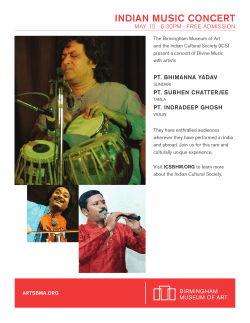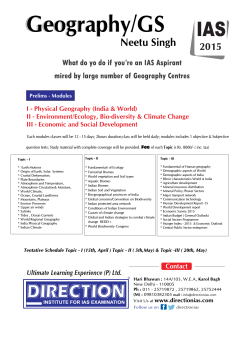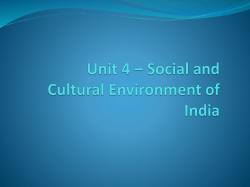
DELINEATION OF SOCIETY IN INDIAN WOMEN
DELINEATION OF SOCIETY IN INDIAN WOMEN AUTOBIOGRAPHIES Ms. Viral Upadhyay Asst. Professor, Vivekanand College for BBA, VNSGU, Surat, Gujarat, India Abstract: It is a common psychological phenomenon that every individual is eager to know how the world looks from inside another person’s experience, and when that desire is met by a convincing narrative, one finds it deeply satisfying. This satisfaction comes from being allowed inside the experience of another person who really lived and who tells about experiences which did in fact occur. This feeling of satisfaction and sometimes even of purgation makes the reading and the study of autobiographies very significant. An effective analysis of an autobiographical writing makes the reading more appealing by showing how a person has negotiated the problem of self-awareness and whether he/she has been able to break the internalized code a culture supplies about how life should be experienced. On the surface, a reader may think that he is just reading a gripping story, but what really grips him/her is the inner reflection on our own lives the autobiographer sets in motion. Keywords: margins, society, culture, feminism, gender I. INTRODUCTION Every individual, at some stage of life, is fascinated by other people’s lives, for life-histories have a wide appeal. Life stories of one or another kind have been made familiar to us right from our childhood through oral tradition of story-telling or we have read them somewhere or seen them being enacted on stage or screen. They have been there entertaining or admonishing us, encouraging and inspiring us too. Today, life-histories have made their mark and have come to be identified as an important genre. They include all kinds of modes and media where the experiences, memories, opinions etc. of an individual have been voiced. They may be in the form of biographies, autobiographies, memoirs, travelogues, essays, interviews given by an illiterate informant, the hagiography of a bhakti saint etc. If an effort is made to trace the history of autobiography, it becomes evident that the first autobiographical work was written in Islamic society in the late 11 th century, by Abdallah ibn Buluggin, last Zirid king of Granada. Zahir ud –Din Mohammad Babur, the founder of Mughal dynasty of South Asia kept a journal Baburnama(literally: “Book of Babur” or “Letters of Babur”) which was written between 1493 and 1529. One of the first great autobiographies of the Renaissance is that of the sculptor and goldsmith Benvenuto Cellini (1500-1571) written between 1556 and 1558, and entitled by him simply Vita (Italian : Life). The earliest known autobiography in English is the All rights reserved by www.ijaresm.com 1 IJARESM early 15th century Booke of Margery Kempe, describing among other things her pilgrimage to the Holy Land and visit to Rome. The book remained in manuscript and was not published until 1936. Notable English autobiographies include those of Lord Herber Cherbury (1643, published 1764) and John Bunyan (Grace Abounding to the Chief of Sinners, 1666). So far as autobiographies penned down by women in the West is concerned, critics observe that by the second half of the nineteenth century, women’s access to education and the emergence of the women’s professions provided a new social territory from which women could examine the meaning of their lives and comment upon their society. Many life-histories of women’s struggle for education and successful battles with discrimination tell us of lives devoted to the quest for success as many educated women gained national stature and founded prestigious institutions and exercised considerable power. But, women are traditionally considered to be meek, submissive and docile, and therefore, when they decide to render their life-history on the pages of an autobiography, the elements of feminism also undoubtedly blend into the creative process. There is a remarkable distinction between the autobiographical writings of a woman and a man. This is evident not only in India but round the world. A woman’s autobiography generally deals with the various relationships like those with her parents, siblings and with her spouse, children and other women of her family set up. Her identity is established only because of these relationships in her life. A man’s autobiography is mainly concerned with his success story, achievements and the world of work. He rarely focuses on his family relationships. Thus, women’s autobiographies deal mainly with the emotional turbulence of women and their relationships in the social set up. II. WOMEN AUTOBIOGRAPHIES : PAST AND PRESENT Looking at the literary history, we realize that the study of autobiographies is comparatively a newer trend, though life-histories are as old as any other genres of literature. The first autobiography written by an Indian woman is considered to be an autobiography published in 1865, by a woman from a village called Ramdia in rural Bengal was a first for India in many ways. It was the first autobiography by an Indian on record. And that too by a woman. In a fiercely male controlled society, a belief was widely held and promoted that women by sex, are not capable of reading and writing. Rassundari Devi's biography was the first proof that women are capable of learning how to read and write. But, until the end of the nineteenth century and the beginning of the twentieth, women autobiographies lack an authoritative voice. They could speak only of family or religion. However, it was in the 20 th century that women autobiographies became a regular feature in the literary scenario of the nation. The autobiographies from Sunity Devee‟s “The Autobiography of a Princess‟(1921) to Padma Desai‟s “Breaking Out”(2012) exhibit the inner world of women with women‟s point of view. In the later part of twentieth century, we find autobiographers like Amrita Pritam, Kamla Das, Shobha De, Dilip Tiwana, Sharanjeet Shan and Mrinal Pande who are very frank in the expression of their innermost feelings. They have boldly expressed the social inhibitions and cultural taboos laid down by the society. Other women autobiographers like Vijayalaxmi Pandit, Krishna Hutheesing and Nayantara Sahgal have written their All rights reserved by www.ijaresm.com 2 IJARESM autobiographies basically about the Indian struggle for freedom. Hence, their autobiographies have political leanings too. With the passing of time, along with the conventions and customs of the Indian society, the focus, the moods and the modes of expressions of the Indian women autobiographers also changed. From the earlier themes of national and social relevance and the reticent mood of the writers, the genre has moved on to giving a voice to more private emotions and expressions of the innermost feelings and passions of the women. A few decades ago, the list of women autobiographers would remind us of the who‟s who list of political or social arena, but today even a woman-next-door, if willing, pens down her lifehistory if it contains something of interest and inspiration to the reading public. III. DEPICTION OF SOCIETY Autobiographies of women are an effective source of examining the interrelationship of an individual and the society, how the gender of the writer affects her life and social status, to what extent the caste or the culture play a role in shaping the individual‟s life, whether the writer‟s experience of being physically disabled or marginalized, any different from her male counterpart. The fulfillment of this objective can be achieved by adopting a research approach which focuses on finding out the answers to the following questions: What motivates the writers to pen down their autobiographies? Is it to reach the goal of self-realization or simply to share the kinds of experiences and the sorts of people they encountered in life? What kind of response the autobiographies elicit? Are they inspirational, throw light on the feminine sensibility; reveal an insight into the lives of the marginalized class they belong to? How do the writers tackle the delineation of their own lives? Are they able to maintain objectivity and express a neutral point of view? How effectively do the writers translate the chaotic ebb and flow of experience into a narrative form? What is the writer‟s response to her gender identity? What is her feminist stand? As women autobiographers, when and where these writers seem to have trouble with their narrative. What do they intend to establish through their works? IV. SIGNIFICANCE OF STUDYING AN AUTOBIOGRAPHY Today, autobiography is perhaps the only kind of writing which tackles such questions in language a non-expert can read with ease. The technical language of history, psychology, criticism, philosophy make the concepts explain even more complex and hence shut out a non-specialist from depending on these disciplines for the scrutiny of his or her own life. Writing an autobiography is not an end in itself. But, they are of significant historical use. They are the printed material through which social reality can be examined. This aspect of historical understanding makes the study of autobiographies very significant. An analysis of autobiographies imbues awareness about the problems of gender, disability, dalit sensibility and other societal issues that women in India face in their day-toAll rights reserved by www.ijaresm.com 3 IJARESM day existence. Autobiographies serve as a catalyst for the readers and prove inspirational in braving the challenges of their own lives. India is generally perceived as essentially a society composed of castes, religious communities, kinship networks and regional assertiveness. It is also believed that as a result of this, a sense of selfhood and personal identity is muted and is lost in the larger social and cultural entities. A study of autobiographies enables us to understand precisely the complex forces at work in modern societies and to concentrate more accurately on the major themes that dominate the sub-continent – gender, modernity, nationalism, ethnicity, social change, religion, family and interrelationship between self and society. V. CONCLUSION Autobiographies reveal insights not just into the experiences and attitudes of the individuals concerned, but also of the society in general or of the specific social/cultural/regional/tribal group the writer belongs to. This helps a lot in understanding and analyzing groups that are in some way marginalized and hence not normally heard, such as women, dalits, disables etc. Today, in India, there can be observed a partial move away from the polished biographies and autobiographies of the „great and famous‟ toward the rendering and analysis of more marginalized and subaltern sections of society. The justification behind selecting and analyzing the autobiographies of womenwhose culture has been termed as „sub-culture‟ by some critics, and especially women who have been further marginalized either socially, physically, geographically or culturally- is that their lives are generally not accessible by other means and their individual voices which actually represent the plight of many other such marginalized groups are silenced by the more dominant forces at play. Critics even use the phrase „double discrimination‟ for women of marginalized groups. REFERENCES [01] Conway Jill Ker, Reflections on Autobiography, The New York Times Company, 1998. [02] Harish Ranjana, Indian Women’s Autobiographies, 2003, Arnold Publishers. [03] Naikar Basavaraj, Critical Response to Indian English Literature, Shanti Prakashan, Rohatak, 2009. [04] Prasad Gauri Shankar and Hrithesh K. Singh, Social Anthropology, Crescent Publishing Corporation, New Delhi, 2012 [05] Sodhi Meena, Indian English Writing : The Autobiographical Mode, Creative Books, New Delhi, 1999. [06] A History of Feminist Literary Criticism, 2007, Plain Gill and Sellers Susan (Ed.), Cambridge University Press. [07] Indian English Literature : Marginalized Voices, 2003, Singh Avdhesh Kumar(Ed.), Creative Books, New Delhi. [08] Telling Lives in India – Biography, Autobiography, and Life History, 2004, Permanent Black, Delhi. [09] Women, Autobiography, Theory : A Reader, 1998, Smith Sidonie and Watson Julia (Ed.), The University of Wisconsin Press. All rights reserved by www.ijaresm.com 4
© Copyright 2025









